The 1630 Comet of Doom
© Christy K. Robinson
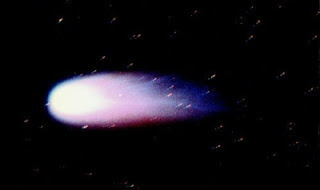 When we hear theprediction of a comet, many of us set an alarm to wake up at oh-dark-thirty, gooutside with a telescope, and peer at blurry blobs on the horizon. I did thatseveral times, for Halley's, Ikeya-Zhang, and Hale-Bopp. The best I couldrecognize with binoculars was a tiny, glowing cotton ball. But life went on asusual each time, because our culture no longer associates doom with a chunk oficy dust passing through our solar system.
When we hear theprediction of a comet, many of us set an alarm to wake up at oh-dark-thirty, gooutside with a telescope, and peer at blurry blobs on the horizon. I did thatseveral times, for Halley's, Ikeya-Zhang, and Hale-Bopp. The best I couldrecognize with binoculars was a tiny, glowing cotton ball. But life went on asusual each time, because our culture no longer associates doom with a chunk oficy dust passing through our solar system. For thousands of years, a comet was believed to presagedeath, disease, famine, and war. It was considered by many cultures to be asign of divine favor or judgment.
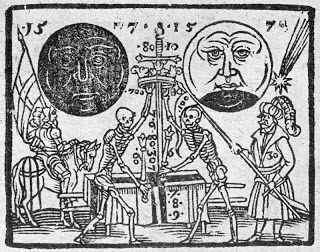 1607 Halley's Comet (though it wasn't yet named for Halley):
1607 Halley's Comet (though it wasn't yet named for Halley): Note the skeletons (death), the crown, the sword, and
the warriors connected with the comet.A noon-time comet was reported in England,Germany, and Italy on May 29and 30, 1630. It was said to resemble a second sun and to shine sobrightly that there was a double shadow.
The comet of 1630 was described by Abbot Assi of Milan as a blazing star,with a "savage face," and of a "horificaspecie," ("horrific kind"). He said that it preceded "de peste quae fuit anno1630" ("the pestilence which was the year 1630").
Sure enough, in Englandand much of Europe, plague and famine followedthe comet sighting.
Mary Barrett, age 19, and William Dyer, 21, who didn't marryuntil 1633, lived in Londonat the time of the comet, and they almost certainly witnessed it. In thebubonic plague which struck Europe and Englandthat year, they came through unscathed, though surely they lost friends andrelatives when a third of London's citizens died. Perhaps they fled the city forsome months, like other people who had the financial means to do so. (There will be another post soon, specifically about plagues.)
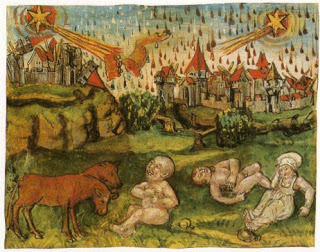 Germany in 1513.Note the blood dripping from the sky
Germany in 1513.Note the blood dripping from the skyand the two-headed animal, a"monster" that was a sign
of God's judgment against heresy. The middle personin the
foreground has the buboes of the Black Death. Trees have been
broken,and several towers have fallen, probably in earthquakes.
These things happened, it was believed, because of the comets.In New England, about 300of the 1000 settlers in Massachusetts Bay Colony died of fever, scurvy, andaccident, and their winter of 1630-31 was called The Starving Time. Consideringthat they'd emigrated to Americato found a New Jerusalem, the colonists must have wondered how they haddispleased God, to be visited so harshly.
Stars and comets also were believed to mark special datesconnected with world events, like births or deaths of kings. Some think it wasHalley's Comet that shown in the sky over Bethlehem in 12 BC.
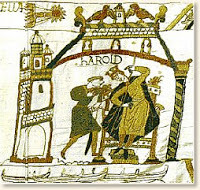 The 1066 Halley's comet,
The 1066 Halley's comet, depicted in Bayeux Tapestry. The
English believed it prophesied doom.Halley's Comet, said tobe four times the size of Jupiter, showed itself in 1066, a year of cataclysmin England,as Edward the Confessor died and Harold was anointed king in violation of hisoath of fealty to William "The Conqueror," Duke of Normandy. William won thecrown for himself later that year.
The first comet toappear in the heavens of New England, of which there is any account, blazedforth from Orion from the ninth to the twenty-second of December, 1652. It waslarge, and people shuddered when they looked at its beautiful tail of fire.
The people connectedtheir appearance with some famine, plague or disaster, either as its directcause or precursor; and the learned men of the times taught the people to feartheir approach. When it is considered that some persons are still disturbed attheir coming in this very end of the nineteenth century, it is readilyunderstood why the people of the days when superstition was fostered trembledat their appearance. They seemed to be the perfection of instruments toaccomplish the burning of the world.
The clergy of NewEngland sought to make the most of this belief and fear, either hypocritically,to simply increase the membership of their churches, or because they shared thecommon belief and honesty endeavored to have souls prepared for the greatchange that might come immediately, and without further warning. At theseperiods many were brought into the fold, and the ordinances and services of thechurch were more carefully observed. –The Essex [Massachusetts]Antiquarian magazine, 1898, edited by Sydney Perley
Other momentous events, not necessarily negative, were associated with comets. When the noon-day comet appeared in May 1630, it was believed to mark thebirth of Charles II, the son of the English King Charles I and his queenHenrietta Maria.
After the EnglishCivil War of the 1640s, the execution of Charles I, and Oliver Cromwell's Protectorate, Charles II had beenrestored to the monarchy for some months before his coronation, which wasplanned for his birthday, May 30, 1660. The publicity lauded him as a sortof messiah unifying the war-torn kingdom, and mentioned the 1630 birth comet as proof of him being God's choice foranointed king.
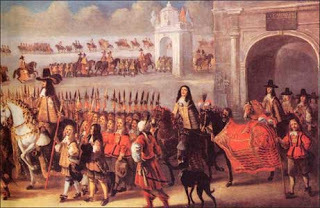 Charles II coronation procession, May 30, 1660.
Charles II coronation procession, May 30, 1660. It looks very messianic with the white gate and clouds.The poet Waller referred to the comet in his coronationpoem, "On St. James's Park," in the lines, His thoughts risehigher, when he does reflectOn what the world mayfrom that star expect,Which at his birthappeared, to let us seeDay, for his sake,could with the night agree!A Prince on whom suchdiff'rent lights did smile,Born the divided worldto reconcile!
Charles II was crowned in London two days before Mary Dyer was hanged in Boston for civildisobedience to the church-state authority.
The next comet to appear was in 1661, the Ikeya-Zhang. You can read an account from 1799 that described the connection between comets and practically every other disaster known to man, HERE.
Published on September 23, 2011 23:22
No comments have been added yet.



